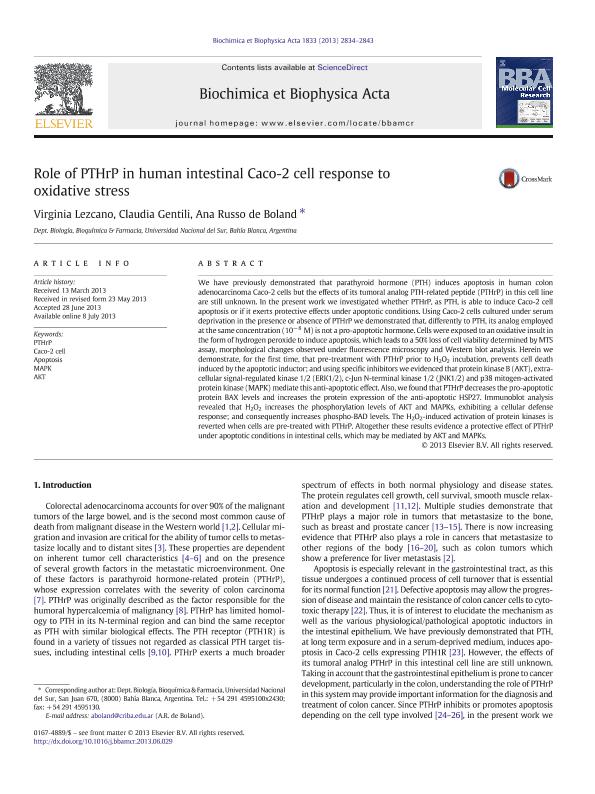Mostrar el registro sencillo del ítem
dc.contributor.author
Lezcano, Virginia Alicia

dc.contributor.author
Gentili, Claudia Rosana

dc.contributor.author
Russo, Ana Josefa

dc.date.available
2016-08-10T22:47:15Z
dc.date.issued
2013-07
dc.identifier.citation
Lezcano, Virginia Alicia; Gentili, Claudia Rosana; Russo, Ana Josefa; Role of PTHrP in human intestinal Caco-2 cell response to oxidative stress; Elsevier; Biochimica Et Biophysica Acta-molecular Cell Research; 1833; 12; 7-2013; 2834-2843
dc.identifier.issn
0167-4889
dc.identifier.uri
http://hdl.handle.net/11336/7084
dc.description.abstract
We have previously demonstrated that parathyroid hormone (PTH) induces apoptosis in human colon adenocarcinoma Caco-2 cells but the effects of its tumoral analog PTH-related peptide (PTHrP) in this cell line are still unknown. In the present work we investigated whether PTHrP, as PTH, is able to induce Caco-2 cell apoptosis or if it exerts protective effects under apoptotic conditions. Using Caco-2 cells cultured under serum deprivation in the presence or absence of PTHrP we demonstrated that, differently to PTH, its analog employed at the same concentration (10− 8 M) is not a pro-apoptotic hormone. Cells were exposed to an oxidative insult in the form of hydrogen peroxide to induce apoptosis, which leads to a 50% loss of cell viability determined by MTS assay, morphological changes observed under fluorescence microscopy and Western blot analysis. Herein we demonstrate, for the first time, that pre-treatment with PTHrP prior to H2O2 incubation, prevents cell death induced by the apoptotic inductor; and using specific inhibitors we evidenced that protein kinase B (AKT), extracellular signal-regulated kinase 1/2 (ERK1/2), c-Jun N-terminal kinase 1/2 (JNK1/2) and p38 mitogen-activated protein kinase (MAPK) mediate this anti-apoptotic effect. Also, we found that PTHrP decreases the pro-apoptotic protein BAX levels and increases the protein expression of the anti-apoptotic HSP27. Immunoblot analysis revealed that H2O2 increases the phosphorylation levels of AKT and MAPKs, exhibiting a cellular defense response; and consequently increases phospho-BAD levels. The H2O2-induced activation of protein kinases is reverted when cells are pre-treated with PTHrP. Altogether these results evidence a protective effect of PTHrP under apoptotic conditions in intestinal cells, which may be mediated by AKT and MAPKs.
dc.format
application/pdf
dc.language.iso
eng
dc.publisher
Elsevier

dc.rights
info:eu-repo/semantics/openAccess
dc.rights.uri
https://creativecommons.org/licenses/by-nc-nd/2.5/ar/
dc.subject
Pthrp
dc.subject
Caco-2 Cell
dc.subject
Apoptosis
dc.subject
Mapk Akt
dc.subject.classification
Bioquímica y Biología Molecular

dc.subject.classification
Ciencias Biológicas

dc.subject.classification
CIENCIAS NATURALES Y EXACTAS

dc.title
Role of PTHrP in human intestinal Caco-2 cell response to oxidative stress
dc.type
info:eu-repo/semantics/article
dc.type
info:ar-repo/semantics/artículo
dc.type
info:eu-repo/semantics/publishedVersion
dc.date.updated
2016-05-10T14:34:12Z
dc.journal.volume
1833
dc.journal.number
12
dc.journal.pagination
2834-2843
dc.journal.pais
Países Bajos

dc.journal.ciudad
Amsterdam
dc.description.fil
Fil: Lezcano, Virginia Alicia. Universidad Nacional del Sur. Departamento de Biología, Bioquímica y Farmacia; Argentina. Consejo Nacional de Investigaciones Cientificas y Tecnicas. Centro Cientifico Tecnológico Bahia Blanca. Instituto de Ciencias Biologicas y Biomedicas del Sur; Argentina
dc.description.fil
Fil: Gentili, Claudia Rosana. Universidad Nacional del Sur. Departamento de Biología, Bioquímica y Farmacia; Argentina. Consejo Nacional de Investigaciones Cientificas y Tecnicas. Centro Cientifico Tecnológico Bahia Blanca. Instituto de Ciencias Biologicas y Biomedicas del Sur; Argentina
dc.description.fil
Fil: Russo, Ana Josefa. Universidad Nacional del Sur. Departamento de Biología, Bioquímica y Farmacia; Argentina
dc.journal.title
Biochimica Et Biophysica Acta-molecular Cell Research

dc.relation.alternativeid
info:eu-repo/semantics/altIdentifier/url/http://www.sciencedirect.com/science/article/pii/S0167488913002528
dc.relation.alternativeid
info:eu-repo/semantics/altIdentifier/doi/10.1016/j.bbamcr.2013.06.029
dc.relation.alternativeid
info:eu-repo/semantics/altIdentifier/doi/http://dx.doi.org/10.1016/j.bbamcr.2013.06.029
Archivos asociados
